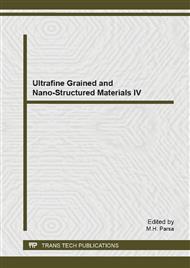[1]
Xian-Yang Feng, Zhe Wang, Chang-Wen Zhang, and Pei-Ji Wang, Electronic Structure and Energy Band of IIIA Doped Group ZnO Nanosheets, Hindawi Publishing Corporation Journal of Nanomaterials Volume 2013, Article ID 181979, 6 pages.
DOI: 10.1155/2013/181979
Google Scholar
[2]
S. A. Wolf, D. D. Awschalom, R. A. Buhrman, J. M. Daughton, S. von Molnár, M. L. Roukes, A. Y. Chtchelkanova, and D. M. Treger, A Spin-Based Electronics Vision for the Future, Science 294 (2001) 1488-1495.
DOI: 10.1126/science.1065389
Google Scholar
[3]
Y. Ohno, D. K. Young, B. Beschoten, F. Matsukura, H. Ohno, and D. D. Awschalom, Electrical spin injection in a ferromagnetic semiconductor heterostructure, Nature 402 (1999) 790-792.
DOI: 10.1038/45509
Google Scholar
[4]
Dana A. Schwartz, Kevin R. Kittilstved, and Daniel R. Gamelina, Above-room-temperature ferromagnetic Ni2+-doped ZnO thin films prepared from colloidal diluted magnetic semiconductor quantum dots, Appl. Phys. Lett. 85 (2004) 1395- 1397.
DOI: 10.1063/1.1785872
Google Scholar
[5]
J. K. Furdyna and J. Kossut, in Semiconductors and Semimetals, edited by J. K. Furdyna and J. Kossut (Academic, New York, 1988).
Google Scholar
[6]
K. Sato and H. Katayama-Yoshida, Electronic structure and ferromagnetism of transition-metal-impurity-doped zinc oxide, Physica B 308 (2001) 904-907.
DOI: 10.1016/s0921-4526(01)00834-1
Google Scholar
[7]
K. Ueda, H. Tabata, and T. Kawai, Magnetic and electric properties of transition-metal-doped ZnO films Appl. Phys. Lett. 79 (2001) 988-990.
DOI: 10.1063/1.1384478
Google Scholar
[8]
Y. M. Cho, W. K. Choo, H. Kim, D. Kim, and Y. Ihm, Effects of rapid thermal annealing on the ferromagnetic properties of sputtered Zn1−x(Co0. 5Fe0. 5)xO thin films, Appl. Phys. Lett. 80, 3358, (2002) 3358 (3 pages).
DOI: 10.1063/1.1478146
Google Scholar
[9]
P. Sharma, A. Gupta, K. V. Rao, F. J. Owens, R. Sharma, R. Ahuja, J. M. O. Guillen, B. Johansson, and G. A. Gehring, Ferromagnetism above room temperature in bulk and transparent thin films of Mn-doped ZnO, Nat. Mater 2 (2003) 673-677.
DOI: 10.1038/nmat984
Google Scholar
[10]
N. S. Norberg, K. R. Kittilstved, J. E. Amonette, R. K. Kukkadapu, D. A. Schwartz, and D. R. Gamelin, Synthesis of Colloidal Mn2+: ZnO Quantum Dots and High-TC Ferromagnetic Nanocrystalline Thin Films, J. Am. Chem. Soc. 126 (2004) 9387–9398.
DOI: 10.1002/chin.200442011
Google Scholar
[11]
K. Sharda, Jayanthi, Santa Chawla, Synthesis of Mn doped ZnO nanoparticles with biocompatible capping, Appl. Surf. Sci, 256 (2010) 2630–2635.
DOI: 10.1016/j.apsusc.2009.11.008
Google Scholar
[12]
V. D. Mote1, Y. Purushotham, and B. N. Dole1, Structural and morphological studies on Mn substituted ZnO nanometer-sized crystals, Cryst. Res. Technol. 46 (2011) 705-710.
DOI: 10.1002/crat.201100107
Google Scholar
[13]
Yao-Ming Hao, Shi-Yun Lou, Shao-Min Zhou, Rui-Jian Yuan, Gong-Yu Zhu and Ning Li, Structural, optical, and magnetic studies of manganese-doped zinc oxide hierarchical microspheres by self-assembly of nanoparticles, doi: 10. 1186/1556-276X-7-100, Nanoscale Research Letters, (2012).
DOI: 10.1186/1556-276x-7-100
Google Scholar
[14]
M. Ebrahimizadeh Abrishami, A. Kompany, S. M. Hosseini, N. Ghajari Bardar, Preparing undoped and Mn-doped ZnO nanoparticles: a comparison between sol–gel and gel-combustion methods, J Sol-Gel Sci Technol 62 ( 2012) 153–159.
DOI: 10.1007/s10971-012-2701-2
Google Scholar
[15]
S. J. Parikh, J. Chorover, FTIR Spectroscopic Study of Biogenic Mn-Oxide Formation by Pseudomonas putida GB-1, Geomicrobiol J. 22 (2005) 207-218.
DOI: 10.1080/01490450590947724
Google Scholar
[16]
R. Ullah, J. Dutta, Photocatalytic degradation of organic dyes with manganese-doped ZnO nanoparticles, Journal of Hazardous Materials 156 (2008) 194-200.
DOI: 10.1016/j.jhazmat.2007.12.033
Google Scholar
[17]
J. W. Li, L. W. Yang, Z. F. Zhou, Paul K. Chu, X. H. Wang, J. Zhou, L. T. Li, and Chang Q. Sun, Bandgap Modulation in ZnO by Size, Pressure, and Temperature, J. Phys. Chem. C 114 (2010) 13370–13374.
DOI: 10.1021/jp104204y
Google Scholar
[18]
X. J. Liu, Z. F. Zhou, L. W. Yang, J. W. Li, G. F. Xie, S. Y. Fu, and C. Q. Sun, Correlation and size dependence of the lattice strain, binding energy, elastic modulus, and thermal stability for Au and Ag nanostructures, J. Appl. Phys., 109 (2011).
DOI: 10.1063/1.3569743
Google Scholar


